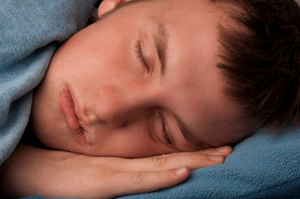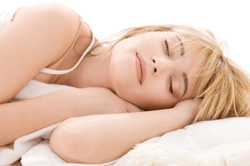
Delayed Sleep Phase Syndrome (DSPS): is a common entity in adolescence that often is blamed on “just being a teenager.” DSPS is a circadian rhythm disorder that results in a shift in the sleep-wake schedule toward later sleep times and later awakening. A shift of 1 to 2 hours of the sleep/wake cycle can be a normal occurrence during puberty, but DSPS is an extreme shift that interferes with school and can result in poor school performance and behavioral abnormalities. Affected adolescents typically experience difficulty in initiating and terminating sleep at a “normal” time and prefer later sleep times (between 2:00 am and 6:00 am) and wake times (between 10:00 am and 1:00 pm). The adolescent is late for school and may fall asleep in school. On holidays and weekends, he or she can experience undisturbed, restful sleep from 4 AM until 2 PM, which suggests that a full restful night’s sleep is attainable, but only with a shifted schedule. Intervention is aimed at reshifting the sleep-wake schedules toward times that meet academic and social needs. However, that is much easier said than done.
There is a high incidence of relapse after discontinuation of treatment, especially if patients are unable to maintain a rigid sleep/wake schedule. So, sometimes the help of a sleep medicine specialist in needed. The following are a few tips:
- Chronotherapy: Delay the sleep times of adolescent patients by 3 hours each day over a period of 5 to 6 days until the desired sleep time is reached. Sounds counterintuitive but it has been shown fairly effective.
- Modified Chronotherapy: The teen stays awake one whole night and day, then goes to bed 90 minutes earlier than usual and maintains the new bedtime for a week. This process is repeated weekly until the desired bedtime is reached.
- Light Therapy. An alternative approach is to have the patient get up and stare into a bright light box for 30 minutes first thing in the morning to “reset the clock.”
- Maintain a strict schedule even on weekends.
- Good Sleep Hygiene:
- Sleep only when sleepy. If you can’t fall asleep within 20 minutes, get up and do something boring until you feel sleepy. Sit quietly in the dark or read the warranty on your refrigerator. Don’t expose yourself to bright light while you are up. The light gives cues to your brain that it is time to wake up.
- Don’t take naps. This will ensure you are tired at bedtime. If you just can’t make it through the day without a nap, sleep less than one hour, before 3 pm.
- Get up and go to bed the same time every day. Even on weekends! When your sleep cycle has a regular rhythm, you will feel better.
- Refrain from exercise at least 4 hours before bedtime. Regular exercise is recommended to help you sleep well, but the timing of the workout is important. Exercising in the morning or early afternoon will not interfere with sleep.
- Develop sleep rituals. It is important to give your body cues that it is time to slow down and sleep. Listen to relaxing music, read something soothing for 15 minutes, have a cup of caffeine free tea, or do relaxation exercises.
- Have a light snack before bed. If your stomach is too empty, that can interfere with sleep. However, if you eat a heavy meal before bedtime, that can interfere as well. Dairy products and turkey contain tryptophan, which acts as a natural sleep inducer. Tryptophan is probably why a warm glass of milk is sometimes recommended.
- Make sure you are unplugged. There should be no TV, computer access or texting starting 1 hour before bed. Cell phones and computers should not be in bedrooms or be turned off to discourage frequent interruption and reduce situations causing anxiety before bed.

- Frequent snoring
- Problems breathing during the night
- Sleepiness during the day
- Difficulty paying attention
- Behavior problems
If you notice any of these symptoms, let your pediatrician know as soon as possible. Your pediatrician may recommend a sleep study (polysomnogram) or refer you to a specialist.
Restless Leg Syndrome (RLS): is a disorder in which the patient feels uncomfortable sensations in the legs and even the arms that can result in the need to move the limbs. Symptoms often are more pronounced at night and can result in significantly disturbed sleep. Symptoms are relieved temporarily by motion or exercise. Treatment strategies are still controversial so if you feel your teenager is experiencing such symptom ask you primary care physician.
Narcolepsy: is a sleeping disorder that demonstrates 2 or 3 of the following characteristic symptoms:
- Daytime Sleepiness: Any school-age child who regularly falls asleep during a 30-minute car ride, while watching television or who requires a nap after school suffers from inappropriate daytime sleepiness. Such children should be evaluated for a sleep disorder that affects their sleep quality.
- Cataplexy: Cataplexy should be suspected when a child describes suddenly falling or completely losing all muscle tone associated with some strong emotion. One patient described such an episode associated with the excitement of being involved in her first soccer game. These “drop attacks” tend to become more when the child is suffering from an intercurrent illness.
- Hypnagogic Hallucinations: These vivid, frequently unpleasant hallucinations occur just before the onset of sleep. The hallucinations may be simple (seeing colored shapes or hearing unexplained noises) or complex (hearing threatening statements or having the sensation of being touched by someone or something). They are made more terrifying when accompanied by sleep paralysis, which is the feeling that the child cannot move. Some patients who have narcolepsy suffer from hypnopompic hallucinations, which are similar but occur just on wakening from sleep.
- Sleep Paralysis: Patients may describe a feeling of being unable to move certain parts of their bodies or to speak just before falling asleep or on wakening. This sensation can be especially frightening when combined with hypnagogic or hypnopompic hallucinations.
The treatment of narcolepsy involves lifestyle modifications as well as medications. Affected children are encouraged to adhere to regular sleep and wake times. In addition, allowance must be made for them to take one or two planned 30-minute naps during the day. This adjustment may require modifications to the school schedule. The naps should occur in a quiet, dark room that feels comfortable to the child. Medications are used in conjunction with these lifestyle changes to increase daytime alertness.
